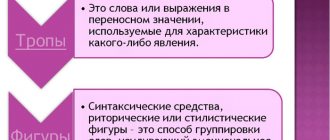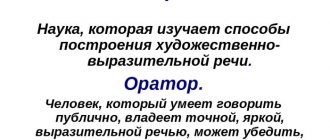Lexical means: tropes
Allegory - Themis (woman with scales) - justice. Replacement of an abstract concept with a concrete image.Hyperbola — Bloomers as wide as the Black Sea (N. Gogol) Artistic exaggeration.Irony - Where are you getting your head from, smart one? (Fable by I. Krylov). Subtle mockery, used in the opposite sense to the direct one. Lexical repetition - Lakes all around, deep lakes. Repetition of the same word or phrase in the textLitota - A small man. An artistic understatement of the described object or phenomenon.Metaphor — Sleepy lake of the city (A. Blok) Figurative meaning of the word based on similarityMetonymy — The class was noisyReplacing one word with another based on the contiguity of two conceptsOccasionalisms - The fruits of education. Artistic means formed by the author.Personification - It is raining. Nature rejoices. Endowing inanimate objects with the properties of living things. Periphrase — Leo = king of beasts. Substitution of a word with an expression similar in lexical meaning.Sarcasm — The works of Saltykov-Shchedrin are full of sarcasm. Caustic, subtle mockery, the highest form of irony.Comparison -When a nightingale speaks a word, it sings. In comparison, there is both that which is compared and that with which it is compared. Conjunctions are often used: as, as if, as if. Synecdoche - Every a penny brings (money) into the house. Transfer of value based on quantitative characteristics.Epithet - “ruddy dawn”, “golden hands”, “silver voice”. A colorful, expressive definition that is based on a hidden comparison.Synonyms - 1) run - rush. 2) The noise (rustle) of leaves. 1) Words that are different in spelling, but close in meaning. 2) Contextual synonyms - words that are similar in meaning in the same context Antonyms - original - fake, callous - responsiveWords with opposite meaningsArchaism - eyes - eyes, cheeks - cheeksAn outdated word or figure of speechPaths in Russian
Metaphor
Metaphor is the use of a word in a figurative meaning based on the principle of similarity; it is called hidden comparison. For example, in Marina Tsvetaeva’s poem we read “And the green of my eyes, and a gentle voice, and the gold of my hair.” Here the word “gold” is used figuratively based on the principle of similarity in color.
In literature one can find extended metaphors, when the same image is revealed over several phrases or even an entire work; An example is the poem by S. Yesenin “The golden grove dissuaded...”, built on several extended metaphors.
Metonymy
Transferring meaning based on the principle of contiguity. For example, in the everyday expression “the kettle has boiled” a metonymy is used: the kettle is not boiling, the water in the kettle is boiling.
Synecdoche
It is close to the previous means, sometimes it is even considered a special case of metonymy. This is the use of a part instead of a whole or vice versa. We find an example of the use of synecdoche in A.S. Pushkin’s poem “The Bronze Horseman”: “All the flags will come to visit us.” The poet used the word "flags" instead of the word "countries".
Epithet
This is a bright, colorful, figurative definition that characterizes a concept or phenomenon. Epithets are very common in poetic speech. For example, in S. Yesenin we read: “I would like to get lost in the greenery of your hundred-ringed ones” (the epithet is the word “hundred-belled”).
Oral folk art is characterized by so-called “constant” epithets: “good fellow”, “red maiden”, “clear moon”, etc.
Comparison
A visual medium based on comparison of one object or phenomenon with another.
Comparison can be made using a comparative phrase or a comparative clause.
Comparisons can also be made using the instrumental case. For example, “he fell to the ground like a stone” = like a stone.
In A. Akhmatova’s poem “Requiem” we read: “They took you away at dawn, she followed you, as if on a takeaway...” Here the comparison is framed in a comparative phrase.
Occasionalisms
These are words coined by the authors themselves. V. Mayakovsky and other futurists have a lot of original neologisms, but they were not the only ones who used occasionalisms.
Some words invented by writers have now entered our language and become commonly used, for example, the word “pilot”, created by V. Khlebnikov.
Periphrase
This is a descriptive statement used instead of directly naming an object or phenomenon. For example, from A.S. Pushkin: “I love you, Peter’s creation!” The paraphrase “Petra creation” means St. Petersburg.
The real genius of periphrasis was M. A. Bulgakov. For example, in the novel “The Master and Margarita” we read: “... the one whom, quite recently, poor Ivan convinced at the Patriarch’s that the devil does not exist. This non-existent one was sitting on the bed.” All this means Woland.
The purposes of using paraphrase are different:
- etiquette (instead of curse words or words that for some reason are considered indecent, for example relating to physiological functions);
- religious or dictated by superstition (“evil” instead of “demon”, “deceased” instead of “dead”; this also includes the names of animals associated with ancient beliefs: bear, etc.);
- strictly literary : for beauty or to avoid unjustified tautology.
Syntactic means
Anaphora - The thunderstorm was not in vain. Repetition of words or combinations of words at the beginning of sentences or poetic lines.Antithesis - Long hair - short mind;.Contrast.Gradation - I came, I saw, I conquered! Arrangement of words and expressions in increasing (ascending) or decreasing (descending) significance.Inversion - Once upon a time there lived a grandfather and a woman. Reverse word order.Compositional junction (lexical repetition) - It was a wonderful sound. It was the best voice I've heard in years. Repeating at the beginning of a new sentence words from the previous sentence, usually ending it. Multi-union - The ocean walked before my eyes, and swayed, and thundered, and sparkled, and faded away. Deliberate use of a repeating conjunction.Oxymoron - Dead souls. A combination of words that cannot be combined in meaning.Parcellation - He saw me and froze. I was surprised. Silenced. Deliberate division of a sentence into semantically significant segments. Rhetorical question, exclamation, appeal - What a summer, what a summer! Who hasn’t cursed the stationmasters, who hasn’t sworn at them? Citizens, let's make our city green and cozy! Expressing a statement in interrogative form; to attract attention; increased emotional impact. Series, pairwise combination of homogeneous members - Nature helps to fight loneliness, overcome despair, powerlessness, forget hostility, envy, and the deceit of friends. The use of homogeneous members for greater artistic expressiveness of the textSyntactic parallelism - To be able to speak is an art. Listening is a culture. (D. Likhachev) Similar, parallel construction of phrases and lines. Default - But listen: if I owe you... I own a dagger, / I was born near the Caucasus. The author deliberately understates something, interrupts the hero’s thoughts so that the reader can think for himself what he wanted to say.Ellipsis - Guys - for the axes! (the word “taken” is missing) Omission of some member of the sentence that is easily restored from the context Epiphora - I've been coming to you all my life. I believed in you all my life. Same ending for several sentences.Means of expression (table) material for preparing for the Unified State Exam (GIA, 9th, 11th grade) on the topic
Language means of expression.
Tropes are the use of a word in a figurative sense.
| List of tropes | Meaning of the term | Example | |
| Allegory | Allegory. A trope consisting in an allegorical depiction of an abstract concept using a concrete, life-like image. | In fables and fairy tales, cunning is shown in the form of a fox, greed - in the form of a wolf. | |
| Hyperbola | A means of artistic representation based on exaggeration. | The eyes are huge, like spotlights. | |
| Grotesque | Extreme exaggeration, giving the image a fantastic character. | The mayor with a stuffed head at Saltykov-Shchedrin. | |
| Irony | Ridicule, which contains an assessment of what is being ridiculed. A sign of irony is a double meaning, where the truth is not what is directly expressed, but its opposite, implied. | Where are you, smart one, coming from, head? (I. Krylov.) | |
| Litotes | A means of artistic representation based on understatement (as opposed to hyperbole). | The waist is no thicker than a bottle neck. (N. Gogol.) | |
| Metaphor, expanded metaphor | Hidden comparison. A type of trope in which individual words or expressions are brought together by the similarity of their meanings or by contrast. Sometimes the entire poem is an expanded poetic image. | With a sheaf of your oat hair You belong to me forever. (S. Yesenin.) | |
| Personification | This is an image of inanimate objects in which they are endowed with the properties of living beings, the gift of speech, the ability to think and feel. | What are you howling about, wind? night, Why are you complaining so madly? (F. Tyutchev.) | |
| Periphrase (or paraphrase) | One of the tropes in which the name of an object, person, phenomenon is replaced by an indication of its most characteristic features, enhancing the figurativeness of speech. | King of beasts (instead of lion) | |
| Synecdoche | A type of metonymy consisting in transferring the meaning of one object to another based on the quantitative relationship between them: part instead of the whole; whole in the meaning of part; singular in the meaning of general; replacing a number with a set; replacement of a specific concept with a generic one. | All flags will be visiting us. (A. Pushkin.); Swede, Russian stabs, chops, cuts. We all look at Napoleons. | |
| Comparison | A technique based on comparing a phenomenon or concept with another phenomenon. | The ice, hardened on the chilly river, lies like melting sugar. | |
| Epithet | Figurative definition; a word that defines an object and emphasizes its properties. | The grove dissuaded golden with Birch's cheerful tongue. | |
FIGURES OF SPEECH
A generalized name for stylistic devices in which a word, unlike tropes, does not necessarily have a figurative meaning.
| Figure | Meaning of the term | Example |
| Anaphora (or unity of command) | Repetition of words or phrases at the beginning of sentences, poetic lines, stanzas. | I love you, Petra’s creation, I love your strict, slender appearance... |
| Antithesis | Stylistic device of contrast, opposition of phenomena and concepts. Often based on the use of antonyms. | And the new so denies the old!.. It ages before our eyes! Already shorter than the skirt. It's already longer! |
| Gradation | Graduality is a stylistic means that allows you to recreate events and actions, thoughts and feelings in the process, in development, in increasing or decreasing significance. | I don’t regret, I don’t call, I don’t cry, Everything will pass like smoke from white apple trees. |
| Inversion | Rearrangement; a stylistic figure consisting of a violation of the general grammatical sequence of speech. | He passed the doorman like an arrow and flew up the marble steps. |
| Lexical repetition | Intentional repetition of the same word in the text. | Forgive me, forgive me, forgive me! And I forgive you, and I forgive you. I don’t hold any grudges, I promise you that, But only you will forgive me too! |
| Pleonasm | Repetition of similar words and phrases, the intensification of which creates a particular stylistic effect. | My friend, my friend, I am very, very sick. |
| Oxymoron | A combination of words with opposite meanings that do not go together. | Dead souls, bitter joy, sweet sorrow, ringing silence. |
| Rhetorical question, exclamation, appeal | Techniques used to enhance the expressiveness of speech. A rhetorical question is asked not with the goal of getting an answer, but for the emotional impact on the reader. | Where will you gallop, proud horse, and where will you land your hooves? (A. Pushkin.) What a summer! What a summer! Yes, it's just witchcraft. (F. Tyutchev.) |
| Syntactic parallelism | A technique consisting in similar construction of sentences, lines or stanzas. | I look to the future with fear, I look at the past with longing... |
| Default | A figure that leaves the listener to guess and think about what will be discussed in a suddenly interrupted statement. | You'll be going home soon: Look... So what? To tell the truth, no one is very concerned about my fate. |
| Ellipsis | A figure of poetic syntax based on the omission of one of the members of a sentence, easily restored in meaning. | We turned villages into ashes, cities into dust, and swords into sickles and plows. (V. Zhukovsky.) |
| Epiphora | A stylistic figure opposite to anaphora; repetition of a word or phrase at the end of poetic lines. | Dear friend, even in this quiet House Fever strikes me. I can’t find a place in a quiet House Near a peaceful fire. (A. Blok.) |
Expressive - emotional vocabulary
| Conversational. | Words that have a slightly reduced stylistic coloring compared to neutral vocabulary, are characteristic of spoken language, and are emotionally charged. | Dirty, loud, bearded. | |||
| Emotionally charged words | Evaluative in nature, having both positive and negative connotations. | Adorable, disgusting, villain | |||
| Words with suffixes of emotional evaluation. | Words with suffixes of emotional evaluation. | Cute, little bunny, little brain, brainchild. | |||
| PICTURE POSSIBILITIES OF MORPHOLOGY | |||||
| 1. Expressive use of case, gender, animation, etc. | Somehow I don't have enough air, I drink the wind, I swallow the fog... We are vacationing in Sochi. How many Plyushkins have divorced! | ||||
| 2. Direct and figurative use of verb tense forms | I came to school yesterday and saw a notice: “Quarantine.” Oh, I was so happy! | ||||
| 3. Expressive use of words from different parts of speech. | The most amazing story happened to me! I received an unpleasant message. I was visiting her. This cup will not pass you by. | ||||
| 4. Use of interjections and onomatopoeic words. | Here's closer! They gallop... and into the yard Evgeniy! "Oh!" — and lighter than a shadow, Tatyana jumped into another hallway. | ||||
SOUND EXPRESSIVENESS
| Means | Meaning of the term | Example |
| Alliteration | A technique to enhance imagery by repeating consonant sounds. | The hiss of foamy glasses and the blue flame of punch... |
| Alternation | Alternation of sounds. Change of sounds that occupy the same place in a morpheme in different cases of its use. | Tangent - touch, shine - shine. |
| Assonance | A technique to enhance imagery by repeating vowel sounds. | The thaw is boring to me: the stench, the dirt, in the spring I am sick. (A. Pushkin.) |
| Sound recording | A technique for enhancing the visual power of a text by constructing phrases and lines in a way that would correspond to the picture being reproduced. | For three days I could hear how on the long, boring road the joints were clicking: east, east, east... (P. Antokolsky reproduces the sound of carriage wheels.) |
| Onomatopoeia | Using the sounds of language to imitate the sounds of living and inanimate nature. | When the mazurka thunder roared... (A. Pushkin.) |
PICTURE POSSIBILITIES OF SYNTAX
| 1. Rows of homogeneous members of a sentence. | When an empty and weak person hears flattering feedback about his dubious merits, he revels in his vanity, becomes arrogant and completely loses his tiny ability to be critical of his actions and his person. |
| 2. Sentences with introductory words, appeals, isolated members. | Probably, there, in my native places, just as in my childhood and youth, the baths bloom in the swampy backwaters and the reeds rustle, making me with their rustle, with their prophetic whispers, the poet that I became, that I was, that I will be, when I die. |
| 3. Expressive use of sentences of various types (complex, complex, non-union, single-part, incomplete, etc.). | They speak Russian everywhere; this is the language of my father and my mother, this is the language of my nanny, my childhood, my first love, almost all the moments of my life that entered my past as an integral property, as the basis of my personality. |
| 4. Dialogic presentation. | - Well? Is it true that he is so good-looking? - Surprisingly good, handsome, one might say. |
| 5. Parcellation is a stylistic technique of dividing a phrase into parts or even individual words in a work in order to give the speech intonation expression through its abrupt pronunciation. | Liberty and Fraternity. There will be no equality. Nobody. No one. Not equal. Never. (A. Volodin.) He saw me and froze. Numb. He fell silent. |
| 6. Non-union or asyndeton - deliberate omission of conjunctions, which gives the text dynamism and swiftness. | Swede, Russian stabs, chops, cuts. People knew: somewhere, very far from them, there was a war going on. If you are afraid of wolves, do not go into the forest. |
| 7. Polyconjunction or polysyndeton - repeating conjunctions serve to logically and intonationally emphasize the parts of the sentence connected by the conjunctions. | The ocean walked before my eyes, and swayed, and thundered, and sparkled, and faded, and glowed, and went somewhere into infinity. I will either burst into tears, or scream, or faint. |
Phonetic means: sound recording
Alliteration - Completehsometimes in the swamp depthswAnd/ Hwow wordswbut, damnwsmart wurshat kamawand - a combination of hissing consonants helps to convey the rustling of the reeds. The repetition of consonants creates an image.Assonance - LYublYu birch treesat Ratsskwow It's brightwow, then gratstnwow – conveys slight sadness and tenderness. Repetition of vowels, creating an image.Gradation - I came, I saw, I conquered! The arrangement of words and expressions is in ascending order (inSolve task 26 of the Unified State Exam in the Russian language with answers.
What are means of expression?
A means of expressive speech is a complex of sound (phonetic), syntactic, lexical or phraseological elements used to achieve a better effect from what is said, attract attention, and emphasize certain aspects in speech.
Highlight:
- Sound (phonetic) means. This includes the use of certain sounds that are repeated periodically, giving a special sound. Symbolist poets often used such methods. For example, the well-known poem by Konstantin Balmont “Reeds” fascinates with hissing sounds that create the effect of the noise of reeds.
- Syntactic. These are the features of sentence construction. For example, V. Mayakovsky has short, sharp phrases that immediately focus attention on the topic.
- Phraseological. This includes the author’s use of phraseological units or so-called catchphrases - aphorisms.
- Lexical and semantic: related to the word and its meaning.
- Paths. They are most often inherent in artistic speech. These are metaphors and metonymies, hyperboles.
Means of expression in the poem “Leaves” by Tyutchev
To better consolidate the topic, we will look at specific poems and, using their examples, we will try to figure out what the techniques of expressiveness are.
This poetic attempt by the writer to understand the meaning of life and mourn its transience is a true masterpiece of landscape lyricism. She is like a monologue of leaves that are sad about their fate and the summer that has flown by so unnoticed.
There are many means of expression here. This is personification (the leaves speak, think, the author presents them to the reader as living beings), and antithesis (the leaves contrast themselves with the pine needles), and comparison (“hedgehog needles” they call pine needles). Here we can also see alliteration techniques (sounds “zh”, “ch”, “sh”).
Playing with tense forms of verbs helps the author achieve the effect of dynamics and movement. Thanks to this technique, the reader practically feels the transience of time and the movement of leaves. Well, like any poem, “Leaves” is not without the use of epithets. There are a lot of them here, they are colorful and alive.
Pay attention to the size of the poem. In just four short lines, the poet uses many means of expression and raises several philosophical questions. Always be attentive when reading poetry, and you will be pleasantly surprised at how much the author tells us.








